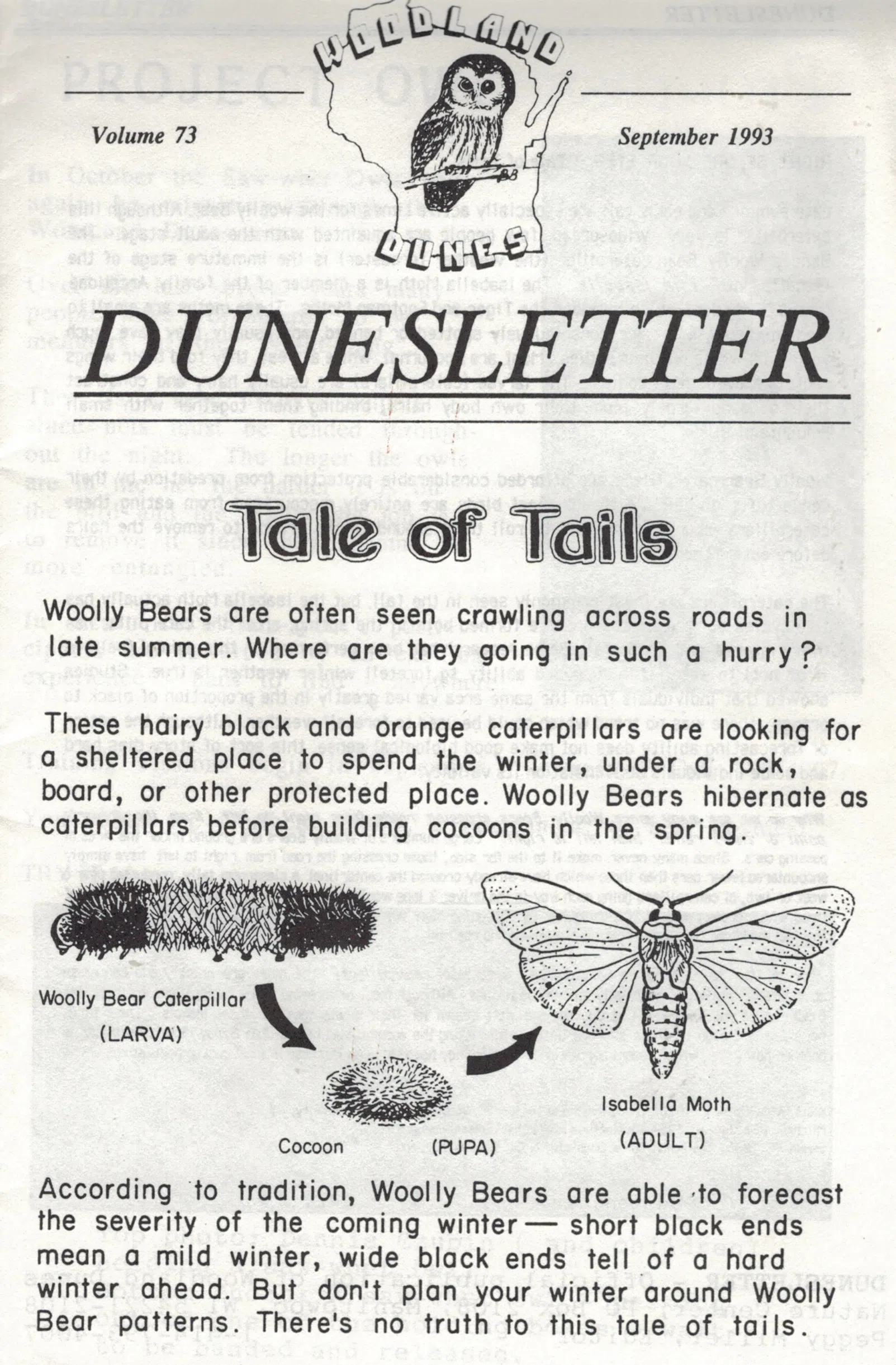Contributed by Nancy Nabak
Dunesletter, September 1993, Volume 73
Woolly Bears are often seen crawling across roads in late summer. Where are they going in such a hurry?
These hairy black and orange caterpillars are looking for a sheltered place to spend the winter, under a rock, board, or other protected place. Woolly Bears hibernate as caterpillars before building cocoons in the spring.
According to tradition, Woolly Bears are able to forecast the severity of the coming winter – short black ends mean a mild winter, wide black ends tell of a hard winter ahead. But don’t plan your winter around Woolly Bear patterns. There’s no truth to this tale of tails.
Late summer and early fall are especially active times for the Woolly Bear. Although this caterpillar is very widespread, few people are acquainted with the adult stage. The Banded Woolly Bear (the weather forecaster) is the immature stage of the Isabella Moth, Isia Isabella. The Isabella Moth is a member of the family Arctiidae (arc-TEE-ih-dee) which includes the Tiger and Footman Moths. These moths are small to medium size, most are conspicuously spotted or banded, and usually they have much yellow or white on their bodies. Most are nocturnal. While at rest, they fold their wings roof-like over their bodies. The larvae (caterpillars) are usually hairy and construct their cocoons largely from their own body hairs, binding them together with small amounts of silk.
Woolly Bear caterpillars are afforded considerable protection from predation by their dense tufts of hair. Although most birds are entirely discouraged from eating these caterpillars, skunks are known to roll them around on the ground to remove the hairs before eating them.
The caterpillars are most commonly seen in the fall, but the Isabella Moth actually has two cycles each year: cocoons are formed both in the spring, after the caterpillar has overwintered, and in the fall. Some research has been performed on this animal (believe it or not) to see if the supposed ability to foretell winter weather is true. Studies showed that individuals from the same area varied greatly in the proportion of black to orange; there was no trend which could be used to foretell the weather. Although the notion of forecasting ability does not make good biological sense, this sort of story dies hard and some individuals still insist on its validity.
Why do we see more Woolly Bears crossing roads from right to left (from the driver’s point of view) rather than left to right? Large numbers of Woolly Bears are ground under the tires of passing cars. Since many never make it to the far side, those crossing the road from right to left have simply encountered fewer cars than those which have already crossed the center line! A classroom tally, conducted over a week or two, of caterpillars going each way in the driver’s lane would provide some clue to the mortality rate of those which cross roads. (200 going left vs. 100 going right would indicate a rate of at least 50%.) If you try this, let me know. I’d like to hear your methods and results!
How do hairs provide protection for these caterpillars? The hairs are prickly and can cause considerable irritation, especially on mucous linings. Although most birds avoid hairy caterpillars entirely, the Black-billed and Yellow-billed Cuckoos are well known for their preference for these insects. These birds periodically slough off their stomach lining, eliminating the accumulated hairs. The Gypsy Moth caterpillar is another hairy one, whose recent population explosion may have led to an increase in local cuckoo populations.











